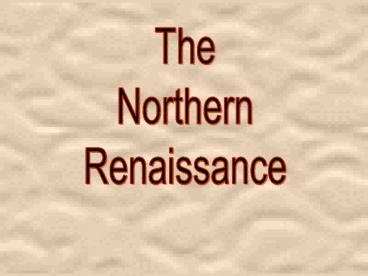Northern Renaissance Art PowerPoint PPT Presentation
1 / 33
Title: Northern Renaissance Art
1
The Northern Renaissance
2
- Italian Renaissance mainly secular
- Northern a mixture of secular and Christian
attitudes. - Northern Humanism- Tried to unite classical
learning and Christian faith, called Christian
humanist. - Hated the worldliness of church excess
- wanted a balance of afterlife and secular
concerns - emphasized bible readings
- wanted to reform church, but also maintain
church. - Will lead to Luthers reformation
- Christian Humanist used education to rescue
church. - Printing Press- Gutenberg invented movable type.
Printed mainly the biblehelp spread Renaissance
ideas along trade routes throughout Europeexcept
Russia
3
Writers
- Erasmus- (1466-1576) prince of the humanists
and voice of moderation. Wrote Praise of
Folly (1512) that ridiculed societys attitudes,
such as ignorance, greed and superstition. Famous
intellectualcalled for tolerance. Erasmus laid
the egg that Luther hatched.books placed on the
Index of Prohibited Books - Thomas More- greatest English humanist. Wrote
Utopia about a flourishing society with no
private ownership, ignorance or superstition. A
satire of 16th C Europe about living better. Very
radical!!! - William Shakespeare- wrote about entire range of
human experience and emotions. - Cervantes-wrote Don Quixotegreatest novel
ever written about medieval chivalry. - Rabelais- wrote Gargantua' about giants who
believed in unrestrained lives and having many
pleasures. - Montaigne- wrote Essay about religious
skepticism and human behavior.
4
Renaissance Art in Northern Europe
- Should not be considered an appendage to Italian
art. - The differences between the two cultures
- Italy ? change was inspired by humanism with its
emphasis on the classical antiquity. - Northern Europe ? change was driven by religious
reform, the return to Christian values, and the
revolt against the authority of the Church.
Tendancy toward realism. - Both have an attention to details.
- Northern Renaissance focused on religious scenes,
portraits, peasants and landscapes.
5
Flemish Realism
6
Giovanni Arnolfini and His Wife(Wedding
Portrait) Jan Van Eyck (1395 1441) 1434
7
Jan van Eyck - Giovanni Arnolfini His Wife
(details)
8
Massys The Moneylender His Wife, 1514
9
(No Transcript)
10
(No Transcript)
11
France
12
Chateau Fontainebleau
- Gallery right by Rosso Fiorentino Francesco
Primaticcio - 1528-1537
13
Germany
14
Albrecht Dürer (1471-1528)
- The greatest of German artists.
- ? Self-Portrait at 26, 1498.
15
Dürer Self-Portrait in Fur-Collared Robe, 1500
16
Dürer The Last Supperwoodcut, 1510
17
England
18
Hans Holbein, the Younger (1497-1543)
- One of the great German artists who did most of
his work in England. - Erasmus Writing, 1523 ?
- Henry VIII was his patron from 1536.
19
Artist to the Tudors
Henry VIII (left), 1540 and the future Edward VI
(above), 1543.
20
- Anne of Cleves
21
Holbeins, The Ambassadors, 1533
A Skull
22
The English Were More Interested in Architecture
than Painting
Hardwick Hall, designed by Robert Smythson in the
1590s, for the Duchess of Shrewsbury more
medieval in style.
23
Burghley House for William Cecil
The largest grandest house of the early
Elizabethan era.
24
The Low Countries
25
Bruegels, Hunters in the Snow, 1565
26
Bruegels, Winter Scene, 1565
27
Bruegels, The Harvesters, 1565
28
Spain
29
El GrecoChrist in Agony on the Cross1600s
30
El GrecoPortrait of aCardinal1600
31
El Grecos, The Burial of Count Orgaz, 1586-1588
32
El Grecos, The Burial of Count Orgaz, 1586-1588
(details)
33
El GrecoThe View of Toledo 1597-1599

